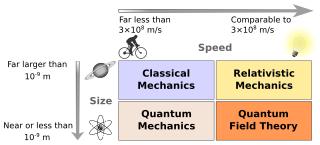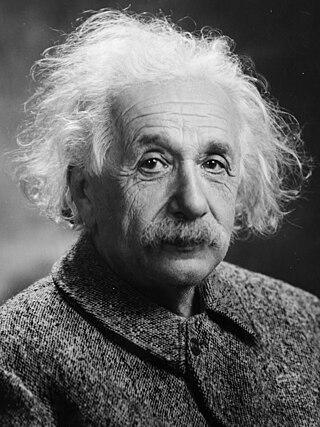Related Research Articles
In physics, the principle of relativity is the requirement that the equations describing the laws of physics have the same form in all admissible frames of reference.

Classical physics is a group of physics theories that predate modern, more complete, or more widely applicable theories. If a currently accepted theory is considered to be modern, and its introduction represented a major paradigm shift, then the previous theories, or new theories based on the older paradigm, will often be referred to as belonging to the area of "classical physics".

Mathematical physics refers to the development of mathematical methods for application to problems in physics. The Journal of Mathematical Physics defines the field as "the application of mathematics to problems in physics and the development of mathematical methods suitable for such applications and for the formulation of physical theories". An alternative definition would also include those mathematics that are inspired by physics, known as physical mathematics.
In physics, action is a scalar quantity that describes how the balance of kinetic versus potential energy of a physical system changes with trajectory. Action is significant because it is an input to the principle of stationary action, an approach to classical mechanics that is simpler for multiple objects. Action and the variational principle are used in Feynman's formulation of quantum mechanics and in general relativity. For systems with small values of action similar to the Planck constant, quantum effects are significant.
In science and especially in mathematical studies, a variational principle is one that enables a problem to be solved using calculus of variations, which concerns finding functions that optimize the values of quantities that depend on those functions. For example, the problem of determining the shape of a hanging chain suspended at both ends—a catenary—can be solved using variational calculus, and in this case, the variational principle is the following: The solution is a function that minimizes the gravitational potential energy of the chain.
In theoretical physics, the Einstein–Cartan theory, also known as the Einstein–Cartan–Sciama–Kibble theory, is a classical theory of gravitation, one of several alternatives to general relativity. The theory was first proposed by Élie Cartan in 1922.
In general relativity and gravitation the Palatini variation is nowadays thought of as a variation of a Lagrangian with respect to the connection.
The Einstein–Hilbert action in general relativity is the action that yields the Einstein field equations through the stationary-action principle. With the (− + + +) metric signature, the gravitational part of the action is given as
Since the 19th century, some physicists, notably Albert Einstein, have attempted to develop a single theoretical framework that can account for all the fundamental forces of nature – a unified field theory. Classical unified field theories are attempts to create a unified field theory based on classical physics. In particular, unification of gravitation and electromagnetism was actively pursued by several physicists and mathematicians in the years between the two World Wars. This work spurred the purely mathematical development of differential geometry.
A classical field theory is a physical theory that predicts how one or more fields in physics interact with matter through field equations, without considering effects of quantization; theories that incorporate quantum mechanics are called quantum field theories. In most contexts, 'classical field theory' is specifically intended to describe electromagnetism and gravitation, two of the fundamental forces of nature.
General relativity is a theory of gravitation that was developed by Albert Einstein between 1907 and 1915, with contributions by many others after 1915. According to general relativity, the observed gravitational attraction between masses results from the warping of space and time by those masses.
In theoretical physics, a scalar–tensor theory is a field theory that includes both a scalar field and a tensor field to represent a certain interaction. For example, the Brans–Dicke theory of gravitation uses both a scalar field and a tensor field to mediate the gravitational interaction.

In physics, Hamilton's principle is William Rowan Hamilton's formulation of the principle of stationary action. It states that the dynamics of a physical system are determined by a variational problem for a functional based on a single function, the Lagrangian, which may contain all physical information concerning the system and the forces acting on it. The variational problem is equivalent to and allows for the derivation of the differential equations of motion of the physical system. Although formulated originally for classical mechanics, Hamilton's principle also applies to classical fields such as the electromagnetic and gravitational fields, and plays an important role in quantum mechanics, quantum field theory and criticality theories.
In physics, a variational principle is an alternative method for determining the state or dynamics of a physical system, by identifying it as an extremum of a function or functional. Variational methods are exploited in many modern software to simulate matter and light.

Classical mechanics is a physical theory describing the motion of objects such as projectiles, parts of machinery, spacecraft, planets, stars, and galaxies. The development of classical mechanics involved substantial change in the methods and philosophy of physics. The qualifier classical distinguishes this type of mechanics from physics developed after the revolutions in physics of the early 20th century, all of which revealed limitations in classical mechanics.

Physics is a scientific discipline that seeks to construct and experimentally test theories of the physical universe. These theories vary in their scope and can be organized into several distinct branches, which are outlined in this article.
In general relativity, the Hamilton–Jacobi–Einstein equation (HJEE) or Einstein–Hamilton–Jacobi equation (EHJE) is an equation in the Hamiltonian formulation of geometrodynamics in superspace, cast in the "geometrodynamics era" around the 1960s, by Asher Peres in 1962 and others. It is an attempt to reformulate general relativity in such a way that it resembles quantum theory within a semiclassical approximation, much like the correspondence between quantum mechanics and classical mechanics.
Lagrangian field theory is a formalism in classical field theory. It is the field-theoretic analogue of Lagrangian mechanics. Lagrangian mechanics is used to analyze the motion of a system of discrete particles each with a finite number of degrees of freedom. Lagrangian field theory applies to continua and fields, which have an infinite number of degrees of freedom.

Albert Einstein's discovery of the gravitational field equations of general relativity and David Hilbert's almost simultaneous derivation of the theory using an elegant variational principle, during a period when the two corresponded frequently, has led to numerous historical analyses of their interaction. The analyses came to be called a priority dispute.
Action principles lie at the heart of fundamental physics, from classical mechanics through quantum mechanics, particle physics, and general relativity. Action principles start with an energy function called a Lagrangian describing the physical system. The accumulated value of this energy function between two states of the system is called the action. Action principles apply the calculus of variation to the action. The action depends on the energy function, and the energy function depends on the position, motion, and interactions in the system: variation of the action allows the derivation of the equations of motion without vector or forces.
References
- ↑ Poisson, Eric (2004). A Relativist's Toolkit: The Mathematics of Black-Hole Mechanics. Cambridge: Cambridge University Press. doi:10.1017/cbo9780511606601. ISBN 978-0-521-83091-1.
- ↑ Hilbert, D. (1915). "Die Grundlagen der Physik . (Erste Mitteilung.)". Nachrichten von der Gesellschaft der Wissenschaften zu Göttingen, Mathematisch-Physikalische Klasse. 1915: 395–408.